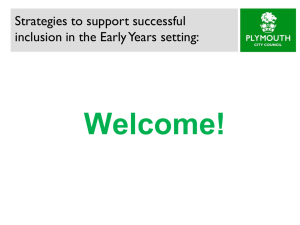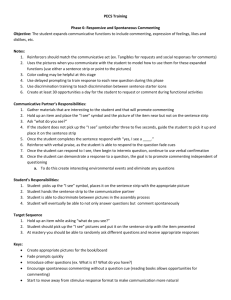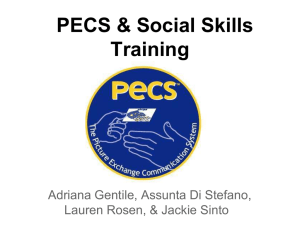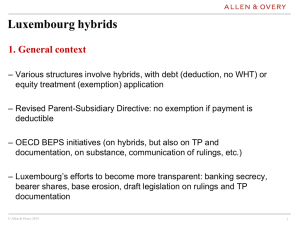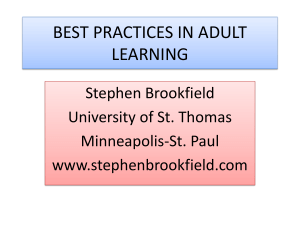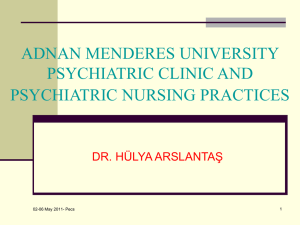PECS: Picture Exchange Communication System Training
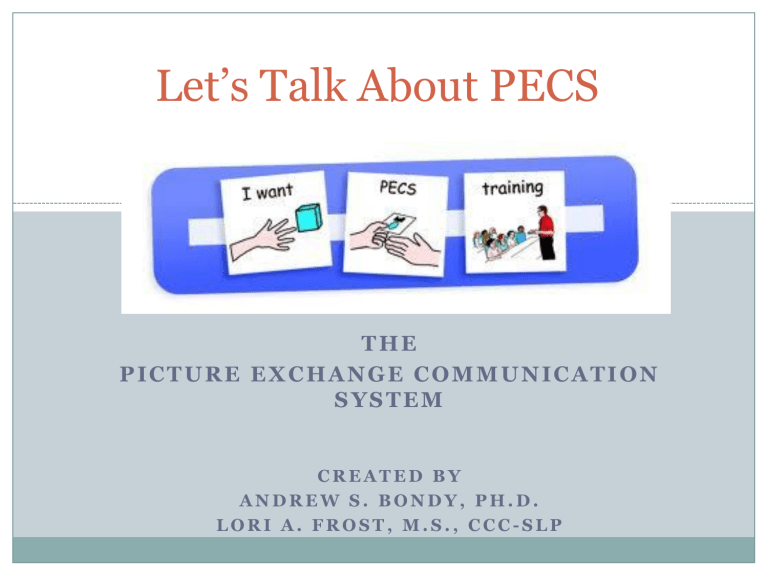
Let’s Talk About PECS
T H E
P I C T U R E E X C H A N G E C O M M U N I C A T I O N
S Y S T E M
C R E A T E D B Y
A N D R E W S . B O N D Y , P H . D .
L O R I A . F R O S T , M . S . , C C C - S L P
Picture Exchange Communication System
Research based w/ many acquiring spoken language
Students are initiators
Dramatic effect upon reducing negative behaviors
It is rapidly acquired
“To Die For” Inventory
3.
4.
1.
2.
Present selection (5-8) of edibles. What does the student go for over and over? Preferred items the student reaches for within 5 seconds.
Remove the most preferred item and watch for what the student goes for next?
Repeat this procedure for toys, books, etc.
Using the most preferred edibles and nonedibles, rank the items by assessing what the student goes for next.
Vocabulary Selection Worksheet
(most to least favored & unconventional)
Things your child likes to eat.
Things your child likes to drink.
Activities your child likes
(watching TV, spinning, sitting in a special chair, squeezing)
Toys your child likes
Social games your child likes (chase, tickle…)
Places your child likes to visit
What your child chooses to do during
“free time”
People your child recognizes and with whom he/she enjoys spending time.
PECS
Phase I
Goal: approaches people to initiate communication trainer student facilitator
Phase 1 The Physical Exchange
Terminal Objective:
Upon seeing a “highly preferred” item, the student will:
1.
2.
3.
Pick up the picture of the item,
Reach toward the trainer,
And release the picture into the trainer’s hand.
Phase 1 Training Protocol
1.
2.
3.
4.
5.
No verbal prompts.
Use more than one preferred item – presented one at a time.
30 opportunities throughout the day for the student to request.
2 trainers are necessary.
Data sheet for Phase 1.
PECS
Phase II
Goal: generalization across people, places, reinforcers, and distance.
Phase II Expanding Spontaneity
Terminal Objective:
The student:
1.
2.
Goes to his/her communication board,
Pulls the picture off,
3.
4.
5.
Goes to the adult,
And releases the picture into the adult’s hand.
Eliminate subtle prompts.
Phase II Training Protocol
1.
2.
3.
4.
5.
6.
7.
No verbal prompts.
Only 1 picture presented at a time.
Conduct reinforcer inventory frequently.
Use a variety of trainers.
30 structured trials + 30 spontaneous.
Fade open hand prompt.
Fade physical assistance.
PECS
Phase III
Goal: Discriminates pictures of objects/activities to request.
PECS Phase III Discrimination Training
Terminal Objective:
The student sill request desired items by:
1.
2.
Going to a communication board,
Selecting the appropriate picture from an array,
3.
4.
5.
Going to a communication partner,
And giving the picture.
Student begins to carry the book.
Phase III Training Protocol
1.
2.
3.
4.
5.
No verbal prompts used during this phase.
Vary position of pictures on the communication board until discrimination is mastered.
Do not say “NO!”
No facilitator needed.
Criterion: 90%
Discrimination Training
1. Teach discrimination between a preferred and a non-preferred item.
A. Set up a situation during which the student is likely to request a particular item. With the object in view and without verbal prompts, present the communication board with 2 pictures on it. If the student gives the appropriate picture, the trainer provides the object and praises the student.
B. If the student gives the wrong picture, give the nonpreferred item and no social reaction.
Teaching Discrimination Strategies
“Blank” Distractor vs
Highly Preferred
Highly preferred vs
Low preferred
3 dimensional
Representation of
Picture
Colored Pix vs black/white
Photo vs
Line drawing
Colored background
Big vs small
Picture lined up with item
Put picture on items.
Fade the item.
4 Step Error Correction
Trainer “shows” correct picture
PROMPT
Trainer “shows” the preferred item again. Prompt the student to give the correct picture. DO NOT give the preferred item – ONLY SOCIAL.
Trainer gives non-related direction or creates “pause”.
Trainer “shows” the preferred item again.
1.
2.
3.
4.
5.
6.
7.
8.
Correspondence Check
When student discriminates between 2-3 items.
Show 2 items on tray.
Present pictures on book.
Student gives the picture.
Present the tray and say, “Take it”.
If student selects corresponding item reinforce.
If student selects the incorrect item, say, “You asked for ___” and gesture toward the preferred item.
Then gesture to the preferred item and say, “If you want this then tell me,” while gesturing to the preferred picture.
Wait 5 seconds. Repeat trial.
PECS
Phase IV
Sentence Structure
Terminal Objective:
1. The student requests present and nonpresent items using multi-word phrase by a. Going to the book, b. Picking up a picture of “I want” c. Picking out a picture of what is wanted, d. Putting the pictures on the sentence strip, e. Removing the strip from the book, f. Approaching the communicative partner, g. And giving the sentence strip to him/her.
Phase IV Training Protocol
3.
4.
1.
2.
5.
No verbal prompts used during this stage.
Continue periodic “correspondence” checks.
Use “backward chaining” to train during this phase.
Create at least 20 opportunities per day for the student to request during functional activities.
The “I want” picture is attached to the left side of the sentence strip. When the child wants a single item, physically guide him/her to put the picture onto the sentence strip next to the “I want” picture. Then guide the child to give the sentence strip to the trainer.
Training Protocol Continued
6. Mastery when student is able to attach the picture of the desired item to the sentence strip (which already contains the “I want” picture).
7.
Moving the “I want” picture to the sentence strip.
8.
Preferred item is not in sight.
9.
Criterion 90%
PECS
Phase V
Goal: Responds to “What do you want?” and spontaneously requests.
PECS
Phase V
Responding to “What do you want?”
Terminal Objective:
The student:
1. Can spontaneously request a variety of items
2. And can answer the question,
“What do you want?”
Phase V Training Protocol
1.
2.
3.
4.
5.
Continue to verbally reinforce each correct response.
Use “delayed prompting” to train during this phase.
Precede and follow each training session with opportunities for spontaneous requesting.
Create at least 20 opportunities per day for the student to request during functional activities.
Criterion 90%
PECS
Phase VI
Goal: Comments and Requests
(in answer and spontaneous)
PECS
Phase VI
Responsive and Spontaneous
Commenting
Terminal Objective:
The student appropriately answers
1. “What do you want?”
2. “What do you see?”
3. “What do you have?”
4. And similar questions when these questions are asked randomly.
Work Together for Communication
Give it a try!
Watch communication begin.
Involve parents.
Have fun!
